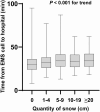Impact of snowfall on emergency medical system and mortality in patients with acute coronary syndrome
- PMID: 40025059
- PMCID: PMC11873150
- DOI: 10.1038/s41598-025-91092-y
Impact of snowfall on emergency medical system and mortality in patients with acute coronary syndrome
Abstract
Acute coronary syndrome (ACS) requires rapid transportation by the emergency medical system (EMS). In snowy areas, traffic conditions may delay EMS transport times and increase mortality rate of ACS. However, there is a paucity of systemic data showing how snowfall affects the EMS and mortality in patients with ACS. This study aimed to investigate the impact of snowfall on the EMS transport times and in-hospital death in patients with ACS. We examined 2387 consecutive ACS patients who were transported via EMS to hospitals participating in the Sapporo City ACS network between April 2013 and April 2023. The patients were divided into two groups based on their arrival on either a snowy day (n = 612, 26%) or a non-snowy day (n = 1775, 74%), as determined by historical weather records from the Japan Meteorological Agency for the Sapporo area. The median age was 68 years, 1754 (74.6%) patients were male. Patients in the snowy day group had longer median time from an EMS call to hospital than those in the non-snowy day group (33 min [IQR 26-40] vs. 29 min [IQR 24-36], P < 0.001). Quantity of snowfall was associated with a delayed time from EMS call to hospital. The proportion of in-hospital death was higher in the snowy day group compared to the non-snowy day group (7.3% vs. 4.6%, P = 0.011). Multivariable logistic regression analysis showed that the snowfall was independently associated with higher incidence of in-hospital death (odds ratio 1.57, 95% confidence interval 1.00-2.47, P = 0.048). In conclusion, snowfall had a significant impact on the EMS and mortality in patients with ACS in an urban city in Japan.
Keywords: Acute coronary syndrome; Emergency medical system; Snowfall.
© 2025. The Author(s).
Conflict of interest statement
Declarations. Competing interests: The authors declare no competing interests.
Figures
References
-
- Mensah, G. A., Roth, G. A. & Fuster, V. The global burden of cardiovascular diseases and risk factors: 2020 and beyond. J. Am. Coll. Cardiol.74(20), 2529–2532 (2019). - PubMed
-
- Spencer, F. A., Goldberg, R. J., Becker, R. C. & Gore, J. M. Seasonal distribution of acute myocardial infarction in the second national registry of myocardial infarction. J. Am. Coll. Cardiol.31(6), 1226–1233 (1998). - PubMed
-
- Danet, S. et al. Unhealthy effects of atmospheric temperature and pressure on the occurrence of myocardial infarction and coronary deaths. Circulation.100, e1–e7 (1999). - PubMed
MeSH terms
LinkOut - more resources
Full Text Sources
Medical
Miscellaneous




